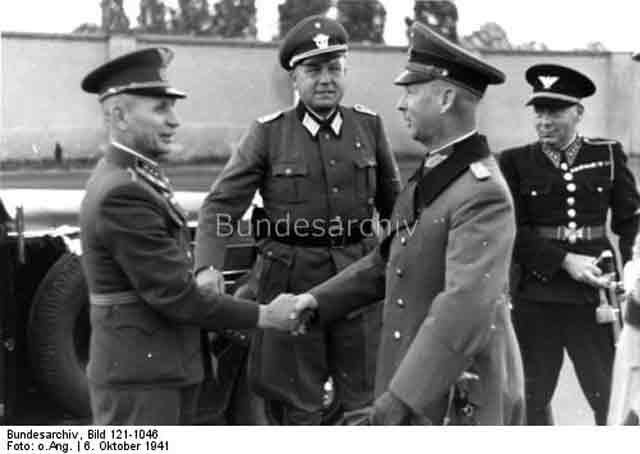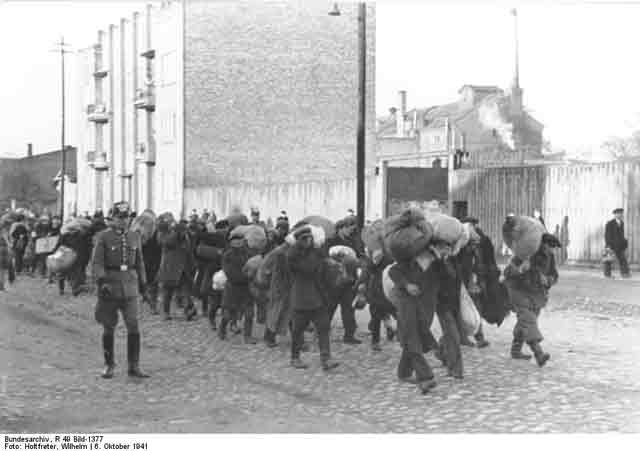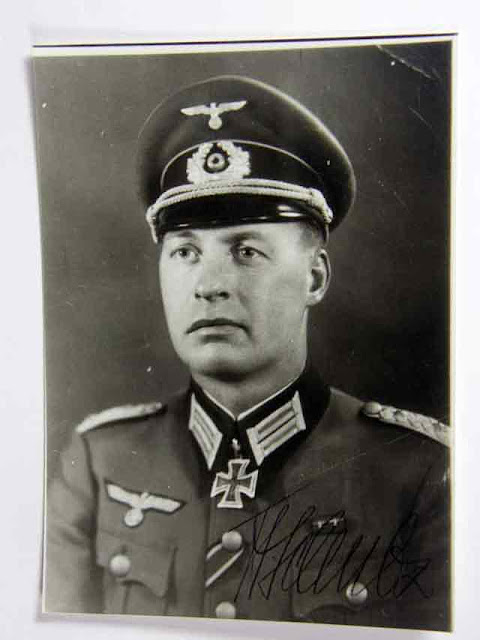Monday 6 October 1941
 |
| "On the right is Lieut Cdr John Bryan Peter Miller, GC, RNVR, (then Lieut) and left, Able Seaman John Tuckwell, GC, with the huge bomb they had rendered safe and had pulled out of the Roding River by crane." 6 October 1941 © IWM (A 29965). |
Eastern Front: The original plan for Operation Barbarossa was extremely sketchy for such a massive operation. One of the odder aspects of planning was that the endpoints for the invasion were never set forth, and became vaguer and more nebulous the further along planning got. The first battle plans, prepared for the OKW by General Erich Marcks in mid-1940, actually did set forth a terminal line of the invasion. Marcks proposed the "A-A line" as the operational objective. This was to run from the northern city of Arkhangelsk on the Arctic Sea through Gorky and Rostov to the port city of Astrakhan at the mouth of the Volga on the Caspian Sea. This assumed that the European portion of Russia and its satellites was the only part of the country of any interest and importance. There, the German Army could stop and set up a sort of
Linea Teutonicus beyond which whatever was left of the Soviet Union could be allowed to wither away, as it would pose no threat.
 |
| Kptlt. Erich Topp, Lt. Weak, and the crew of U-552 as they return to St. Nazaire, France (note the victory pennants), 6 October 1941 (Buchheim, Lothar-Giinther, Federal Archive Picture 101II-MW-3676-28). |
After the Marcks Plan (as it came to be called), though, the idea of any kind of ultimate objective for the Wehrmacht just kind of disappeared. The debate instead degenerated into one of whether or not it was even important to get to Moscow, let alone reach any points further east. The prevailing theory - primarily Hitler's - was that the entire Soviet Union would capitulate after a few decisive border battles destroyed the Red Army.
 |
| Senior Sergeant Ivan Lyubushkin, commander of a Red Army T-34 tank of the 4th (1st Guards) Tank Brigade, destroys 9 panzers of General Guderian's 2nd Panzer Army, 4th Panzer Division at Mtsensk on 6 October 1941. He is named a Hero of the Soviet Union on 10 October 1941. Lyubushkin's driver-mechanic is killed and his radio operator is seriously injured in the action. KIA 30 June 1942. |
Nobody seemed to notice that the Soviet Union spanned eleven time zones and even the most ambitious invasion plans only contemplated occupying territory in two or three of them. There apparently was not a single proposal, let alone plan, for the Wehrmacht to drive to the Pacific. The equipment - the tanks, the assault guns, the artillery - likely never would have made it that far anyway. Ultimately, there were no ultimate objectives set, and the entire operation depended on its conclusion on the Soviets surrendering or being rendered important in their frozen eastern territories.
 |
| General von Bomhard of the Reich police greets visiting Slovak police officers in Berlin, 6 October 1941 (Federal Archive Bild 121-1046). |
Accordingly, there were wild predictions about how short Operation Barbarossa would last before achieving final victory. In Fuhrer Directive No. 21, dated 18 December 1940, Hitler reverted to the Marcks Plan, which had been completely revised in intervening months, for his objectives. That directive states in relevant part under "General Intentions":
The bulk of the Russian Army stationed in Western Russia will be destroyed by daring operations led by deeply penetrating armoured spearheads. Russian forces still capable of giving battle will be prevented from withdrawing into the depths of Russia.
The enemy will then be energetically pursued and a line will be reached from which the Russian Air Force can no longer attack German territory. The final objective of the operation is to erect a barrier against Asiatic Russia on the general line Volga-Archangel.
While there is no exact timeframe given in Fuhrer Directive No. 21, it can be read between the lines as being extremely brief for such a major undertaking.
 |
| The commander of a Sturmgeschutz III on the Eastern Front, October 1941. |
The Fuhrer directive states (translations differ slightly, but
this translation conveys the basic meaning) in part that:
When the battles north and south of the Pripet Marshes are ended the pursuit of the enemy will have the following aims :
In the South the early capture of the Donets Basin, important for war industry.
In the North a quick advance to Moscow. The capture of this city would represent a decisive political and economic success and would also bring about the capture of the most important railway junctions.
Note the critical word in this selection, which is the most telling word in the entire directive:
pursuit. Once the frontier battles have been won, Operation Barbarossa would turn into a
pursuit of fleeing Red Army remnants. There is no more significant word in the entire collection of Fuhrer Directives than this single word
pursuit.
 |
| Mrs. MJ McKew christens HMAS Broome, an Australian minesweeper, at her launching on 6 October 1941. |
As of
6 October 1941, there has been no "pursuit" in the Soviet Union or at least none that has lasted very long. Every step has been contested, every river has been defended, every city has been fought over and sometimes even been boobytrapped after the Red Army has left. The defense has been uncoordinated and lacking in effectiveness on many occasions, but the Red Army has been fighting all the way. Now, the best campaigning months of 1941 are already gone and it is only going to get worse before it gets better again. Given all that, the astounding underestimation of the effectiveness of Red Army opposition during the planning stage of Operation Barbarossa has not really hampered German operations yet, it just has required adjustments to compensate for a slower rate of advance than anticipated. The tanks still run, the trucks still carry supplies, the horses are still fed from grain in the fields. Move a division here, send an army there, and everything gets taken care of even if it happens a little later than planned.
 |
| Jewish residents are marched out of Leslau, Wartheland (Włocławek, Pomerania), Poland, 6 October 1941 (Holtfreter, Wilhelm, Federal Archive R 49 Bild-1377). |
However, everything is about to change forever, and the men on the front lines see why after dark today. The lack of effective antifreeze for trucks or tanks, the lack of chains for wheeled vehicles, the absence of winter clothing which was considered superfluous in June - all of a sudden these omissions loom large. The piles of winter gear sitting in warehouses back in Stuttgart and Mainz suddenly would be very handy at the front, but there are no plans to send them there. The reason for this change in priorities, the reason a little better planning back in the spring would have been a good idea, is very clear and right in front of everyone's eyes: after dark on 6 October 1941, it snows on the road to Moscow.
 |
| Oberst Johannes Schulz (3 February 1902 - 12 September 1991) earns the Knights Cross of the Iron Cross on 6 October 1941 as Major Commander of the I./Infanterie-Regiment 49. |
October 1941
October 1, 1941: Germans and Finns Advance in USSR
October 2, 1941: Operation Typhoon Broadens
October 3, 1941: Air Battles Near Moscow
October 4, 1941: Stalin Contemplates Defeat
October 5, 1941: Hoth Goes South
October 6, 1941: First Snowfall After Dark
October 7, 1941: Stalin Gets Religion
October 8, 1941: FDR Promises Stalin Aid
October 9, 1941: FDR Orders Atomic Bomb Research
October 10, 1941: Reichenau's Severity Order
October 11, 1941: Tank Panic in Moscow
October 12, 1941: Spanish Blue Division at the Front
October 13, 1941: Attack on Moscow
October 14, 1941: Germans Take Kalinin
October 15, 1941: Soviets Evacuate Odessa
October 16, 1941: Romanians Occupy Odessa
October 17, 1941: U-568 Torpedoes USS Kearny
October 18, 1941: Tojo Takes Tokyo
October 19, 1941: Germans Take Mozhaysk
October 20, 1941: Germans Attack Toward Tikhvin
October 21, 1941: Rasputitsa Hits Russia
October 22, 1941: Germans Into Moscow's Second Defensive Line
October 23, 1941: The Odessa Massacre
October 24, 1941: Guderian's Desperate Drive North
October 25, 1941: FDR Warns Hitler About Massacres
October 26, 1941: Guderian Drives Toward Tula
October 27, 1941: Manstein Busts Loose
October 28, 1941: Soviet Executions
October 29, 1941: Guderian Reaches Tula
October 30, 1941: Guderian Stopped at Tula
October 31, 1941: USS Reuben James Sunk
2020








No comments:
Post a Comment